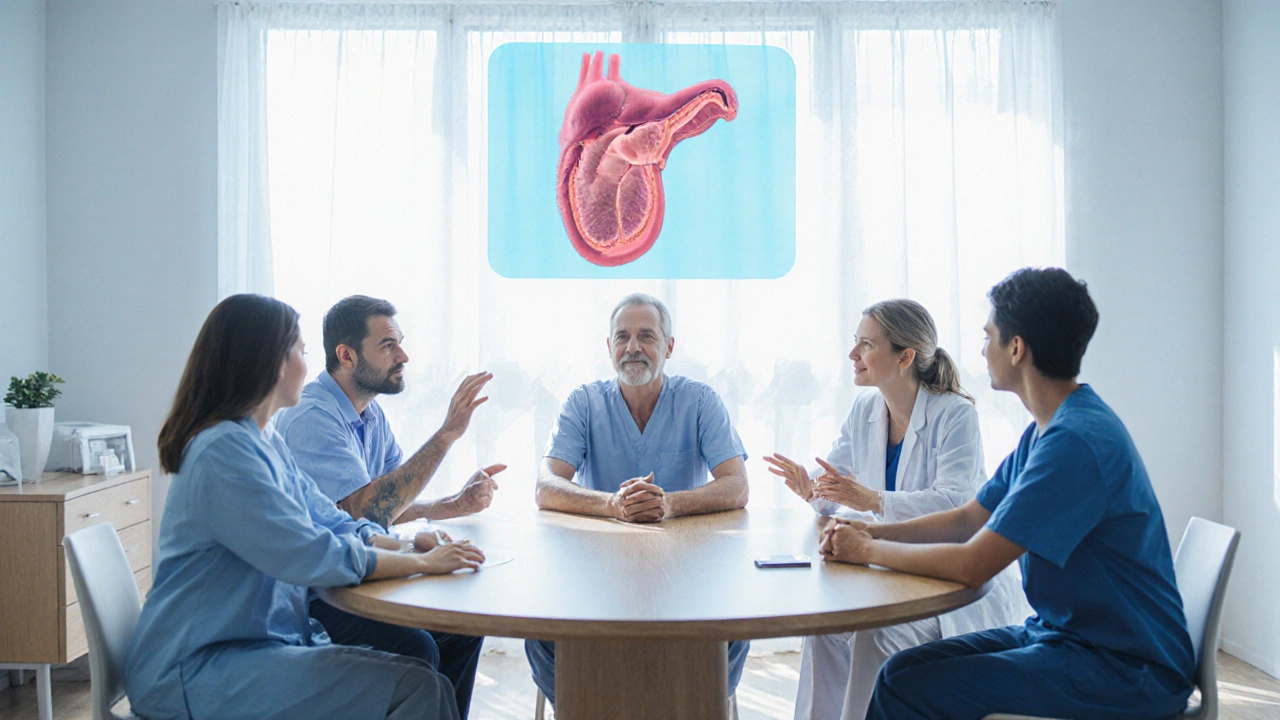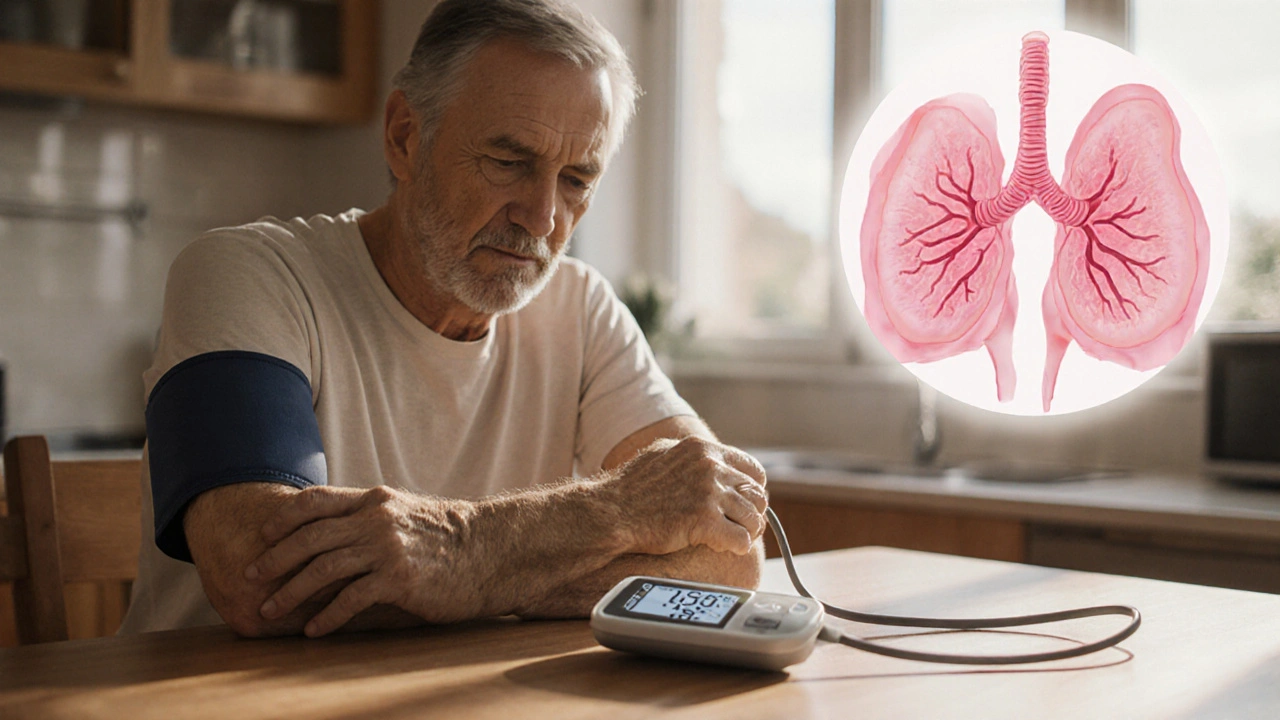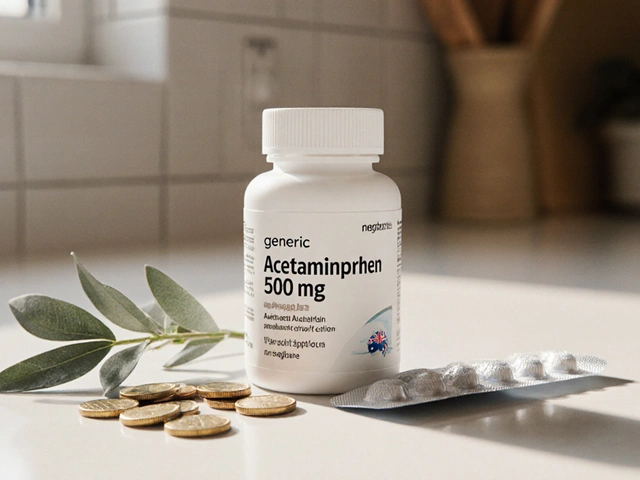Pheochromocytoma Pain Assessment Tool
Pain Assessment Form
Complete this form to track your chronic pain symptoms related to pheochromocytoma. This information helps you and your healthcare team understand patterns and treatment effectiveness.
Your Pain Tracking Log
No assessments saved yet.
Living with Pheochromocytoma is a daily balancing act-fluctuating blood pressure, scary spikes of adrenaline, and, for many, relentless chronic pain. When the pain never truly goes away, quality of life drops, sleep suffers, and even the best‑selling antihypertensives feel like a Band‑Aid. This guide walks you through why the pain sticks around, which medicines actually help, and everyday habits that can turn a miserable cycle into a manageable routine. The goal? Give you a clear plan so you can reclaim control without waiting for a crisis.
Understanding Pheochromocytoma and Its Pain Mechanisms
First, let’s demystify the tumor itself. Pheochromocytoma is a rare adrenal gland tumor that releases excess catecholamines-mainly adrenaline and noradrenaline-into the bloodstream. While the spikes are notorious for causing hypertension, palpitations, and anxiety, they also sensitize nerves and trigger muscle tension, leading to persistent discomfort in the back, abdomen, or joints.
Two key reasons the pain becomes chronic:
- Neurochemical overload: Continuous high levels of catecholamines keep pain pathways on high alert, a phenomenon neurologists call "central sensitization."
- Secondary effects: Hypertension forces the heart to work harder, which can cause micro‑vascular strain in muscles and bones, adding another layer of soreness.
Understanding this loop-tumor → catecholamines → nerve sensitization → chronic pain-helps you target each link with specific treatments.
Assessing Chronic Pain in Pheochromocytoma Patients
Before you can treat the pain, you need a clear picture of its nature. A thorough assessment includes:
- Pain location and quality (sharp, throbbing, burning).
- Intensity on a 0‑10 scale, recorded at different times of day.
- Trigger patterns-does it flare after a hypertensive episode or after physical activity?
- Current medication list, especially antihypertensives, to spot possible side‑effects.
- Impact on daily activities, sleep, and mood.
Bring this log to every specialist appointment. When doctors see a structured record, they can more easily adjust dosages or add targeted therapies.
Medication Strategies for Pain Relief
Medications for pheochromocytoma fall into two buckets: those that control the tumor’s hormone output and those that directly address pain. Here’s how each works.
| Drug Class | Primary Action | Typical Dose | Pain‑Specific Benefit | Key Side‑Effects |
|---|---|---|---|---|
| Alpha‑blocker | Blocks alpha‑adrenergic receptors → lowers blood pressure | Phenoxybenzamine 10‑40mg daily (divided) | Reduces catecholamine‑induced nerve sensitization | Dizziness, nasal congestion |
| Beta‑blocker | Blocks beta‑adrenergic receptors → controls heart rate | Propranolol 20‑80mg daily | Calms tachycardia‑related muscle tension | Fatigue, cold extremities |
| Analgesic (NSAID) | Inhibits COX enzymes → reduces inflammation | Ibuprofen 400‑600mg every 6‑8h | Provides short‑term relief for musculoskeletal flare‑ups | Stomach irritation, renal strain |
| Gabapentinoid | Modulates calcium channels → dampens neuropathic pain | Pregabalin 75‑150mg BID | Targets nerve‑related burning sensations | Drowsiness, weight gain |
| Tricyclic Antidepressant | Inhibits reuptake of serotonin & norepinephrine | Amitriptyline 10‑25mg at bedtime | Helps chronic diffuse pain and improves sleep | Dry mouth, constipation |
Key takeaways:
- Start with alpha‑blockers; they tackle the root hormonal surge.
- If blood pressure is under control but pain persists, add a gabapentinoid or low‑dose tricyclic for nerve‑level relief.
- NSAIDs are useful for occasional muscle aches, but avoid long‑term use because of kidney‑related risks, especially when you’re already on antihypertensives.
Always discuss dosage changes with your endocrinologist-many of these drugs interact with the tumor‑targeting regimen.
Non‑Pharmacologic Approaches
Medications only cover part of the puzzle. Lifestyle tweaks can blunt the pain cycle dramatically.
- Gentle aerobic activity: Walking, swimming, or cycling for 20‑30minutes daily improves circulation, lowers resting catecholamine levels, and releases endorphins.
- Targeted stretching: Yoga poses that lengthen the lumbar and thoracic spine (e.g., Cat‑Cow, Child’s Pose) reduce muscle guard in the back-a common pain hotspot.
- Mind‑body techniques: Guided meditation or diaphragmatic breathing lowers sympathetic output, directly cutting down the adrenaline surge that fuels pain.
- Heat therapy: Warm packs applied to tense areas for 15minutes can relax fibers and temporarily lessen nerve firing.
- Sleep hygiene: Consistent bedtime, cool bedroom temperature, and limited caffeine after noon help keep nocturnal blood‑pressure spikes at bay, which translates to fewer morning aches.
These strategies aren’t one‑size‑fits‑all, but a combination of two or three usually shows measurable improvement within a few weeks.
Multidisciplinary Care and Monitoring
Because pheochromocytoma touches the endocrine, cardiovascular, and nervous systems, a single doctor can’t cover everything. Look for a multidisciplinary team that includes:
- Endocrinologist - steers tumor‑specific therapy.
- Cardiologist - monitors hypertension trends and heart‑rate variability.
- Pain specialist or neurologist - fine‑tunes analgesic regimen.
- Physiotherapist - designs safe movement plans.
- Psychologist - supports coping strategies for chronic illness.
Regular lab work (plasma metanephrines) tracks tumor activity every 3‑6months. Pair that with a home blood‑pressure log and a pain diary, and you’ll have objective data to guide tweaks. If you notice a sudden rise in metanephrine levels, it often precedes a pain flare, giving you a chance to intervene early.

When to Seek Immediate Help
Some pain episodes signal a medical emergency:
- Sudden, crushing chest pain with a blood‑pressure reading >180/120mmHg.
- New‑onset severe headache accompanied by visual disturbances.
- Rapidly worsening abdominal pain that doesn’t respond to usual meds.
- Signs of a hypertensive crisis-palpitations, sweating, confusion.
If any of these appear, call emergency services. Early treatment can prevent organ damage and gives the surgical team a better chance to control the tumor.
Quick Checklist for Daily Pain Management
- Log blood pressure and pain score every morning and evening.
- Take prescribed alpha‑blocker at the same time each day.
- Do a 5‑minute breathing exercise before meals.
- Walk or swim for at least 20minutes; avoid high‑intensity bursts.
- Apply a warm pack to sore muscles after activity.
- Review medication side‑effects weekly; report new dizziness or fatigue.
Stick to the list for two weeks, then note any changes. Small adjustments-like shifting a walk to the cooler part of the day-can make a big difference.
Frequently Asked Questions
Can chronic pain be a sign that the tumor is growing?
Yes. If you notice a steady increase in pain intensity that isn’t linked to daily activities, it often mirrors rising catecholamine production. In such cases, your doctor will likely repeat imaging and metanephrine testing to rule out tumor progression.
Are NSAIDs safe for long‑term use with pheochromocytoma?
Short bursts are usually fine, but chronic NSAID use can strain kidneys and raise blood pressure-both undesirable when you’re already managing hypertension. Talk to your doctor about rotating with acetaminophen or using topical NSAIDs for localized relief.
What role does diet play in pain control?
A low‑sodium, high‑potassium diet helps keep blood pressure steady, which indirectly reduces muscle tension. Additionally, omega‑3‑rich foods (salmon, walnuts) have modest anti‑inflammatory effects that can ease musculoskeletal pain.
Is surgery the only cure for the tumor?
Surgical removal is the definitive treatment, but some patients aren’t surgical candidates due to size, location, or other health issues. In those cases, lifelong medical management with alpha‑blockers and careful pain control becomes the main strategy.
Can exercise worsen my pain?
High‑intensity workouts can trigger catecholamine surges, leading to a pain flare. Stick to moderate‑intensity activities and avoid sudden bursts of effort. Always warm up and cool down to keep muscle fibers relaxed.






Annette van Dijk-Leek
October 6, 2025 AT 18:25Wow, what an incredible guide!! 🎉 You’ve broken down the complex world of pheochromocytoma pain into bite‑size steps!!! Keep it up, you’re empowering so many!! Remember, every little win counts!! 🌟 Stay strong and keep tracking those pain scores!!
Katherine M
October 13, 2025 AT 17:05In contemplating the intricate interplay between catecholamine surges and chronic nociception, one discerns a profound lesson about bodily resilience. The guide deftly illuminates pathways for mitigation, offering both empirical rigor and compassionate counsel. It is commendable how the author integrates interdisciplinary insights, thereby fostering holistic stewardship of health. 😊
Bernard Leach
October 20, 2025 AT 15:45Understanding the neurochemical cascade in pheochromocytoma begins with recognizing the persistent elevation of catecholamines. These hormones continuously stimulate adrenergic receptors and keep the pain pathways sensitized. Central sensitization develops when the nervous system adapts to the constant input and amplifies signals. Consequently patients report pain that is disproportionate to any single trigger. The guide correctly suggests logging intensity at multiple times of day to capture this variability. Regular documentation creates a data set that clinicians can analyze for patterns. Alpha‑blockers reduce peripheral receptor activation and therefore lower the baseline sensitization. However dosage adjustments must be performed under specialist supervision to avoid hypotension. Adding gabapentinoids targets the neuropathic component that arises from chronic adrenergic exposure. Lifestyle interventions such as moderate aerobic exercise assist in normalizing sympathetic tone. Breathing exercises specifically counteract acute catecholamine spikes by engaging the parasympathetic system. Heat therapy can provide temporary relief by relaxing muscle fibers that have been in chronic contraction. Sleep hygiene is essential because nocturnal hypertension often precedes morning pain flares. Multidisciplinary care ensures that endocrine, cardiac, and pain aspects are all addressed simultaneously. By integrating pharmacologic and non‑pharmacologic strategies patients can reclaim functional independence.
Shelby Larson
October 27, 2025 AT 14:25It is absolutley essential that patients do not dismiss chronic pain as merely a psychosomatic complaint; such a view is both scientifically inaccurate and ethically indefensible. The guide rightly emphasizes that neglecting appropriate analgesia can lead to unnecessary suffering, a reality that many healthcare systems unfortunately overlook. Moreover, the moral responsibility of clinicians extends beyond merely regulating blood pressure; they must also address the lived experience of pain with compassion and evidence‑based interventions. Failing to do so not only violates the principle of beneficence but also erodes trust in the medical profession. Patients deserve comprehensive care, and any suggestion that they should simply endure pain is, frankly, defenseless. In this context, the recommendation to incorporate both pharmacologic and lifestyle measures is decidedly commendable, albeit it should be implemented with vigilant monitoring to prevent iato‑genic complications. Remember, the pursuit of health must always be guided by respect for human dignity, not by expedient shortcuts. 👎
Mark Eaton
November 3, 2025 AT 13:05Great job laying out a clear daily checklist! It’s practical and makes the whole process feel doable. I especially like the reminder to do a breathing exercise before meals – that’s a simple habit that can really dial down the sympathetic surge. Keep sharing these actionable tips, they’re gold for anyone navigating this condition.
Corey Jost
November 10, 2025 AT 11:45While the guide is thorough, I can’t help but wonder if we’re over‑medicalizing every aspect of daily life. Not every patient needs a warm pack after a 20‑minute walk; sometimes the body just needs to rest without a regimented protocol. Moreover, the emphasis on constant logging might add anxiety rather than relief for certain individuals. A more flexible, patient‑centric approach could be beneficial, allowing people to choose which tools actually serve them rather than feeling obligated to follow every recommendation.
Nick Ward
November 17, 2025 AT 10:25Thanks for the tip 😊